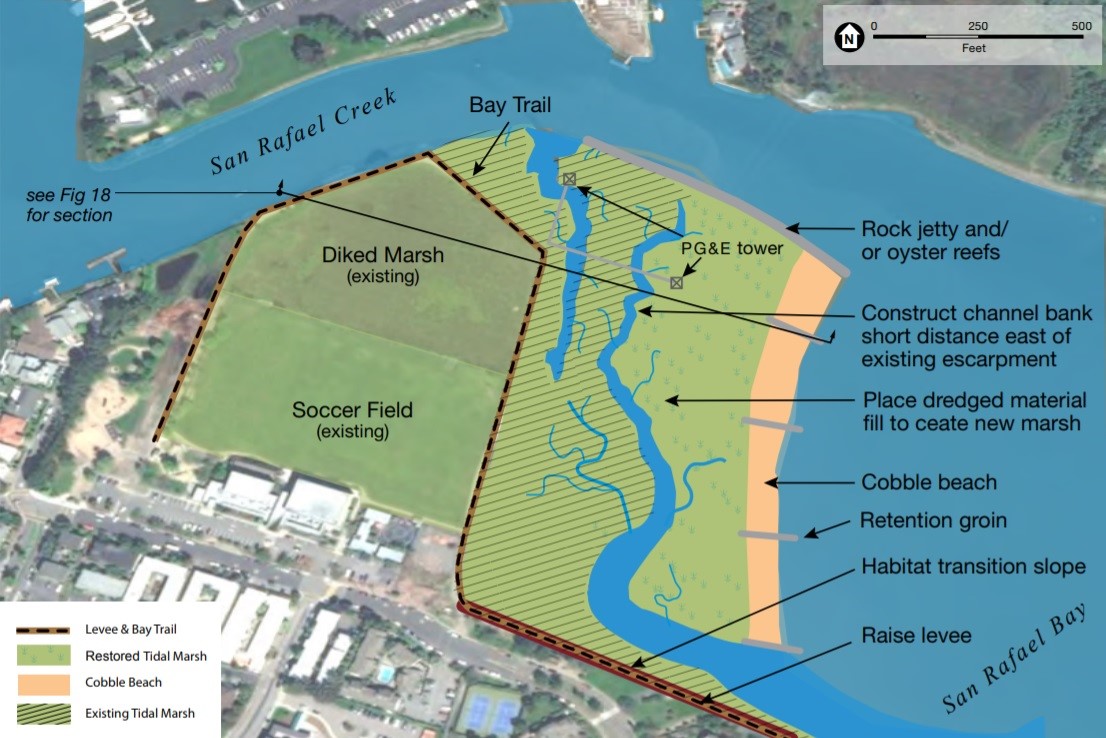
On January 27th Public Works staff, project managers from the US Army Corps of Engineers (USACE), and the Audubon Society Tiscornia Marsh project leads met with the San Francisco Bay Restoration Regulatory Integration Team (BRRIT) to discuss how to address the challenges to getting the Tiscornia Marsh permitted as a deposit location for sediments removed as part of the upcoming San Rafael Channel dredging project. The purpose of the BRRIT is to improve the permitting process for multi-benefit habitat restoration projects and associated flood management and public access infrastructure in the San Francisco Bay. Members of the team include representatives from regulatory agencies U.S. Fish and Wildlife Service (USFWS), NOAA National Marine Fisheries Service (NMFS), San Francisco Bay Regional Water Quality Control Board (RWQCB), California Department of Fish and Wildlife (CDFW), and the San Francisco Bay Conservation and Development Commission (BCDC), and the USACE Regulatory Branch.
The marsh project is still in the design phase, and full design has not been completed at this time. The construction phase of the project is also not funded. Because of this, the Audubon society has not yet pursued acquisition of the various regulatory agency permits necessary to be an officially sanctioned depositary site for sediments dredged from San Francisco Bay. In order for the marsh to receive mud from a possible San Rafael dredging project in 2022 (which would be geographically ideal for the marsh project and for the USACE) – the project would need to obtain permits from these agencies on a fairly expedited basis. Yes – 1.5 years is rather expedited in the world of San Francisco Bay regulatory agency permitting!
The BRRIT will be providing follow up direction and information to the Audubon Society regarding the best path forward. The Audubon Society and the USACE along with the dock owners and harbors along the Channel all stand to benefit greatly if the marsh is able to receive materials dredged from the San Rafael Channel: the proximity of the marsh relative to the Channel would lower the costs for dredging the Channel, and if the marsh was able to receive the Channel dredge materials, it would be virtually free for the Audubon society. Ecologically, it is also ideal for a marshland restoration site to receive materials from within the same watershed. The greatest challenge to the prospect of depositing Channel sediments at Tiscornia Marsh are the permitting impediments to using hydraulic dredging for pumping sediments in a slurry directly into the marsh. This method is the most cost-effective way to move sediments to a nearby location, however, NMFS and CDFW have concerns over impacts to sensitive fish species makes permitting hydraulic dredging very difficult. Dredging in the Channel has historically been conducted using mechanical dredging with a clamshell bucket that digs sediments from the bottom of the Channel and then dumps them into a scow that can be pushed by a tugboat out to the in-Bay disposal site. The added high cost of relocating sediments from a scow to the marsh would likely be cost-prohibitive. As such, the USACE and the Audubon Society will have to overcome the challenges of permitting a hydraulic dredging operation in order to make placement of Channel sediments in the marsh a viable option (i.e. a lower cost than in-Bay disposal with mechanical dredging).

